Ok, this is hardly formal. I was not spending any real effort to match exposures and such, however I did match focal lengths as closely as I could and I did try to get essentially equivalent exposures. I shot these lenses wide open because I don’t really worry about ultimate sharpness when I am wandering about on the trails … but of course there is a major advantage to shooting a test wide open since we are always searching for a lens that does adequate work wide open because one can never really get enough lens speed.
So … I wandered over to one of my favourite places to enjoy the woods on what turned out to be a really warm and sunny late September day here in eastern Canada. Quite gorgeous and I was able to wander about in shorts and a tshirt (which I am still doing as we near the end of the first week in October.)
Now, please do remember that I shoot everything in RAW and process in Lightroom 5. Also remember that I like a warm presentation with very open shadows. Unless there is an artistic reason for it, I dislike dark shadowy areas as the lack of detail creates a hole in the image as far as my brain is concerned.
So as I enter the woods, I am struck by the autumn beauty of the dappled sunlight and the leaves on the ground. And the smells of fresh leaves on the ground remind me so much of my youth in Winnipeg … walking in autumn is so relaxing – I certainly hope that anyone reading this is taking every opportunity.
This shot is taken with the GX1 and the little 14-42 X VARIO PZ pancake zoom. It is a very sharp lens, although as you will see a bit later on my copy is not quite perfect. Still, I find little fault with this image from the sharpness perspective.
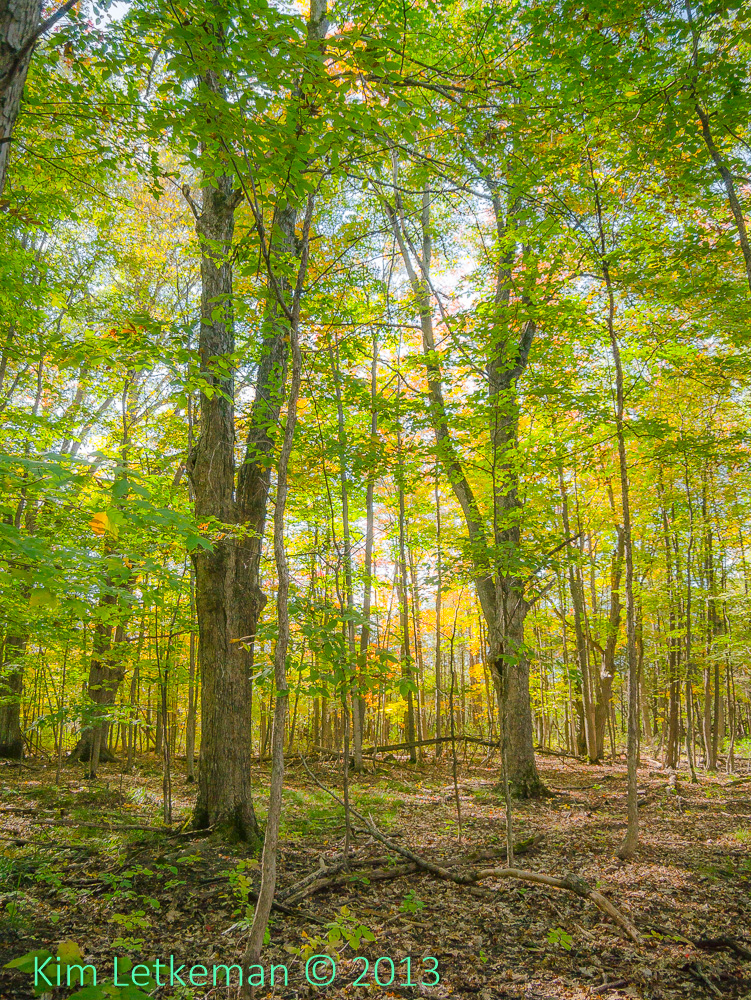
And another from the GX1 followed by the same shot with the G5 and the 14-140 G VARIO.


They are framed slightly differently, but you get the idea … they look very similar and at this small size (click on each to open in a separate window and see them at 1000px) they both look pretty nice.
I was rather dark in the woods and the GH2 tends to select low shutter speeds on auto, so when I encountered my first squirrel I did not get the crispest image … 1/20s on 600mm effective requires 5 stops of OIS and this comes pretty close, but not perfect.

Still, I quite like it. A quintessential nut-gathering day …
After I realized that the blur was being caused by choices being made by the GH2, I fixed ISO to 3200, which is frankly just at the edge of what this first generation 16mp sensor can handle. But I think it did rather nicely. At least, at web sizes :-)

Note: Both images lack the “bite” that you get from that clever combination of (a) stopping down a consumer zoom or using a pro zoom or prime, (b) shooting at low ISO, and (c) perfect technique. I hit the trifecta by not having any of those in play :-)
I shot a number of images as I went along and I won’t bore you (more than I already have) with all of them … if you want to see the series, by all means go directly to my gallery later … http://letkeman.net/Gallery/Nature/walkinthewoods/Stony-Swamp-Beaver-Trail-28-Sep-2013
Here’s a distance shot of the trail with the GH2 and the 100-300. I have always been one to shoot at the extremes quite a bit … full wide for scope and full zoom for isolation, in this case isolating the trail as it curves in the distance.
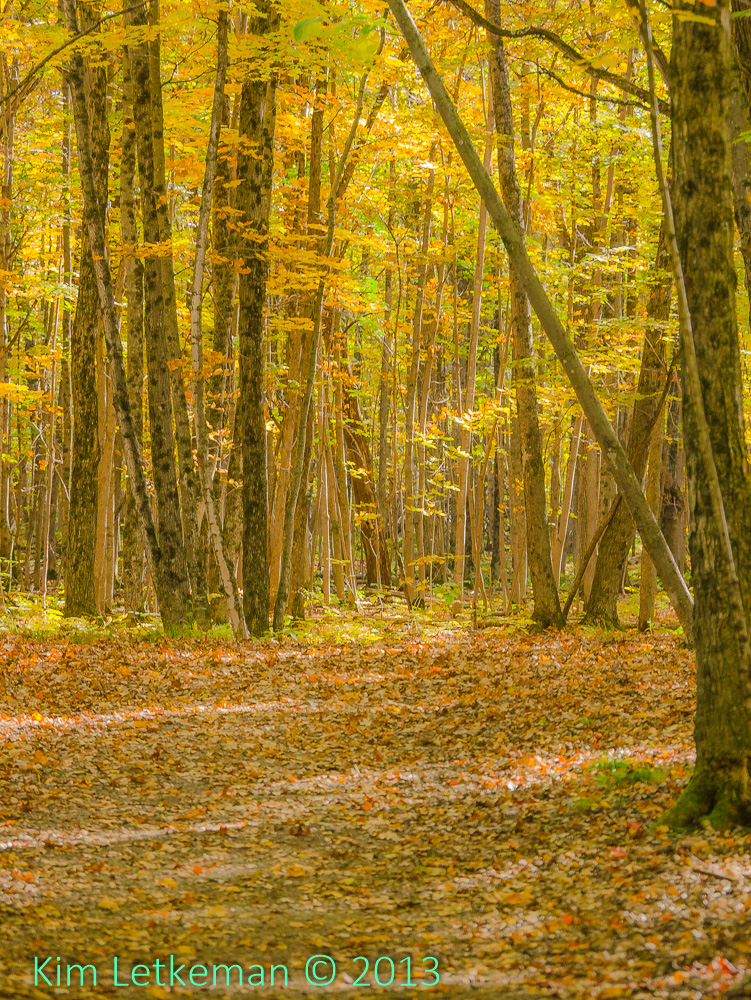
Dappled sunlight can be really challenging, but it also creates interesting shadows. Here is a scenario where I don’t open the shadows and warm things up automatically.

The little pancake on the GX1 certainly makes a decent account of itself in that image. No significant blur, despite details flowing right into all four corners.
As I mentioned a moment ago, I really like isolation with the long end of the zoom. But the 100-300 is so long, that isolation at the short end works decently too … basically this is 200mm EFL at f/5.6 …

As I cross the meadow that leads to the beaver pond and lodge, I see the dark entry back into thick woods off in the distance. The GX1 only has 42mm max, so I use that to show the trail leading up to it.

There is some detail visible way down there, so I grab the G5 and GH2 and shoot it at approximately the same focal lengths. About 10% off, as the EVFs are also a bit different and I was not paying perfect attention … still, it gets interesting and I will be showing crops in a moment.
So here is the G5 at 91mm (182mm EFL) and f/5.8 … the 14-140 is unfortunately a tad slow at the long end.

And now the GH2 with the 100-300 at 5.6 and 100mm (200mm EFL.)

Both look really nice in my opinion, but the definition of the brightly lit branches and grass just before the shadow line is better in the 100-300 image. Since that is a 3x zoom against a 10x zoom, this is actually expected.
To illustrate the classic issue with 10x zooms shot wide open:
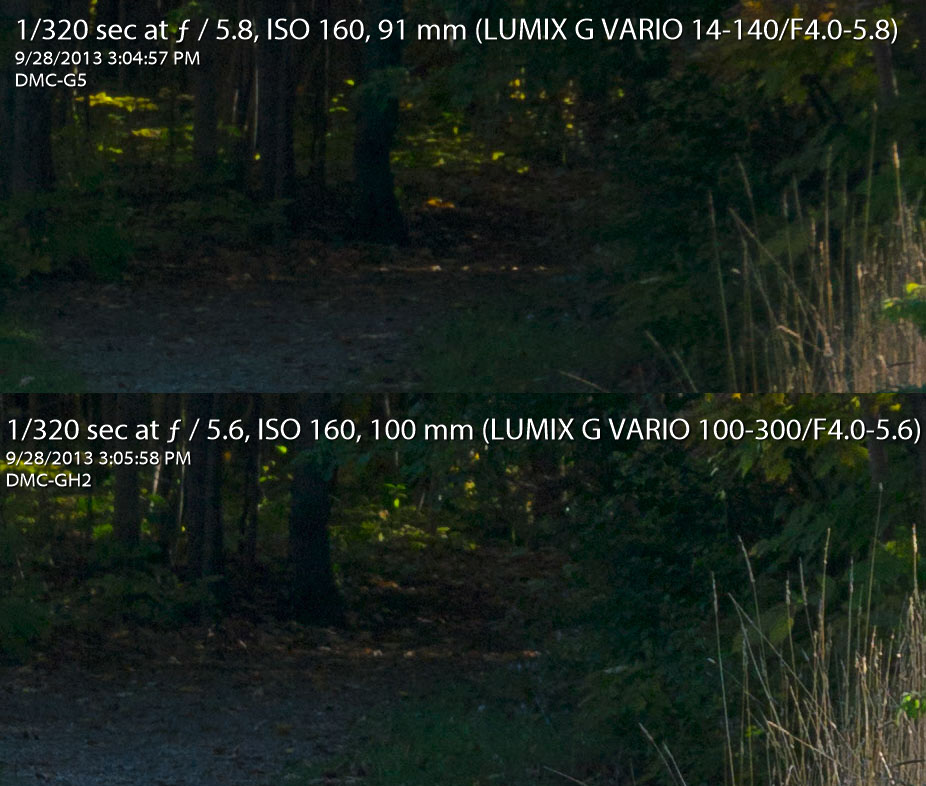
You will want to open up that image to get the full sized 1:1 crop at the pixel level.
What you see here is a loss of contrast and edge definition with the 14-140. It’s actually fairly minor for small image use, since this crop is the moral equivalent of looking at a section of about a 46 inch print … but it is noticeable enough that you would always choose the 100-300 in this case. Also remember that sample variation may be playing a part here too.
The other notable issue is that I pulled up the shadows considerably … at least 1 or 2 stops … and there is minimal grain and no banding. A recent thread on DPReview contained an argument I had with a couple of people who say they saw banding on the GH2 and G5 sensors and when I pressed them it was a 1 in 10,000 occurrence on a bad exposure. But they swore that lifting shadows would do it too.
Well, ok … but I don’t see it here and I have never seen it. And I have already said earlier that I lift shadows habitually …
As I passed the middle of the meadow, I turned to shoot the northern end of the meadow, front lit by the late afternoon sun.
The G5 …

And the GX1 …

They aren’t identical in framing, but they are close enough to grab areas near each edge. What is interesting that each is strong on one side and weak on the other … and they are opposites. The crops show what I mean … and do remember that this is the equivalent of a 46” print, so this is actually a pretty small issue …

I brightened the G5 more, and it shows in the noisier skies. But otherwise, we see that the 14-42 is weak on the left side (my copy, remember) and the 14-140 is ever so slightly weaker in parts of the image on the right side. But again, adequately sharp for most uses. Not gallery quality by any stretch … but anyone shooting for that purpose had better be tripod mounting a nice prime and taking a lot of time to get everything perfect. Else why even bother …
So … exiting the meadow and entering the woods, where there is a tall bush filled with berries. I shot it with the GX1 at 42mm and G5 at 140mm and got this result … it is interesting only from the perspective that people using superzooms talk about macro capabilities as something that matters, when most of the time you just want to shoot at your longest focal length and crop … because that’s how you smooth backgrounds.
I think it will be obvious which of these two was shot at 28mm versus 280mm EFL …


Interestingly, the longer focal length is also a slightly blurred image … another victim of my lack of attention to every detail as I wandered along. And the shorter FL gave a touch of CA on the bottom of the berry at the bottom. Hmmm …
Anyway, if you prefer busy backgrounds, then by all means continue using short focal lengths for close ups.
I arrive at the pond and the water is glass. Very nice … and here is the G5 at full wide angle.

And the G5 at 103mm on the lodge itself … followed by the GH2 at 100mm …

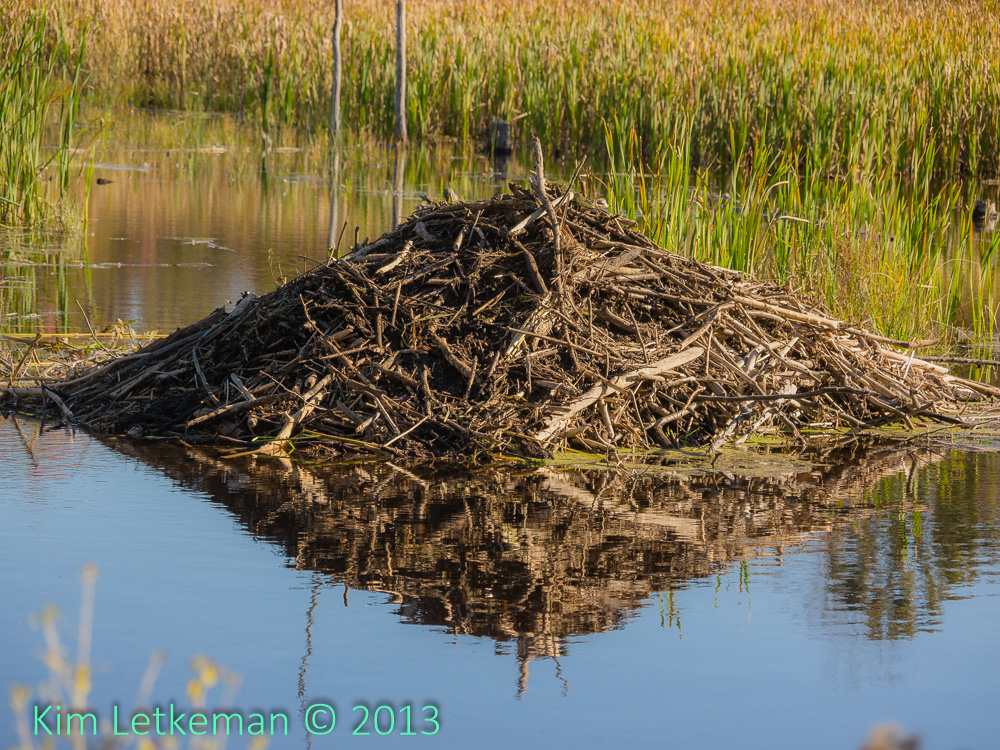
Can you tell that these share a sensor heritage? 
Anyway, I shot some birds and such in a little film and I might put that on YouTube when I get the chance, but for now we’ll just move on. Along the trail a bit later I see a bee doing the bee thing.
One thing I love about the 14-140 is that it focuses quite closely, giving very decent shots of flowers and insects. Not equivalent to a real macro lens, but not bad at all.

The GH2 chooses a higher ISO (1600 vs the G5’s choice of 1000) and the 100-300 does a fantastic job otherwise. I love what this lens does to backgrounds at 600mm EFL.

The difference in clarity of the bee is again fairly obvious.
The next boardwalk over the swamp takes us to a swamp where I tend to find a lot of great looking dragonflies. This is where I shot the dragonfly that was featured in the local newspaper the last two weeks in a row. And I saw what is probably the same one on this day …
But first … a shot of a chickadee … I never miss an opportunity when they are feeding to try to grab a nice shot. The colors are pretty excellent this time of year …

I clipped the end of the tail, so I figured I would go for a vertical composition here …. it’s only tolerable, but the color and detail is pretty nice in my opinion. And here is a shot of the whole bird with a nice view of his eye …

And now, enter the dragon (boooooonnnnnnggggggg) … sounds like a Bruce Lee movie.
This particular one is a great shot of the berries and not such a great shot of the insect, largely because I shot wide open. Stopping down to 7.1 or 8 would have created a much better microcontrast …
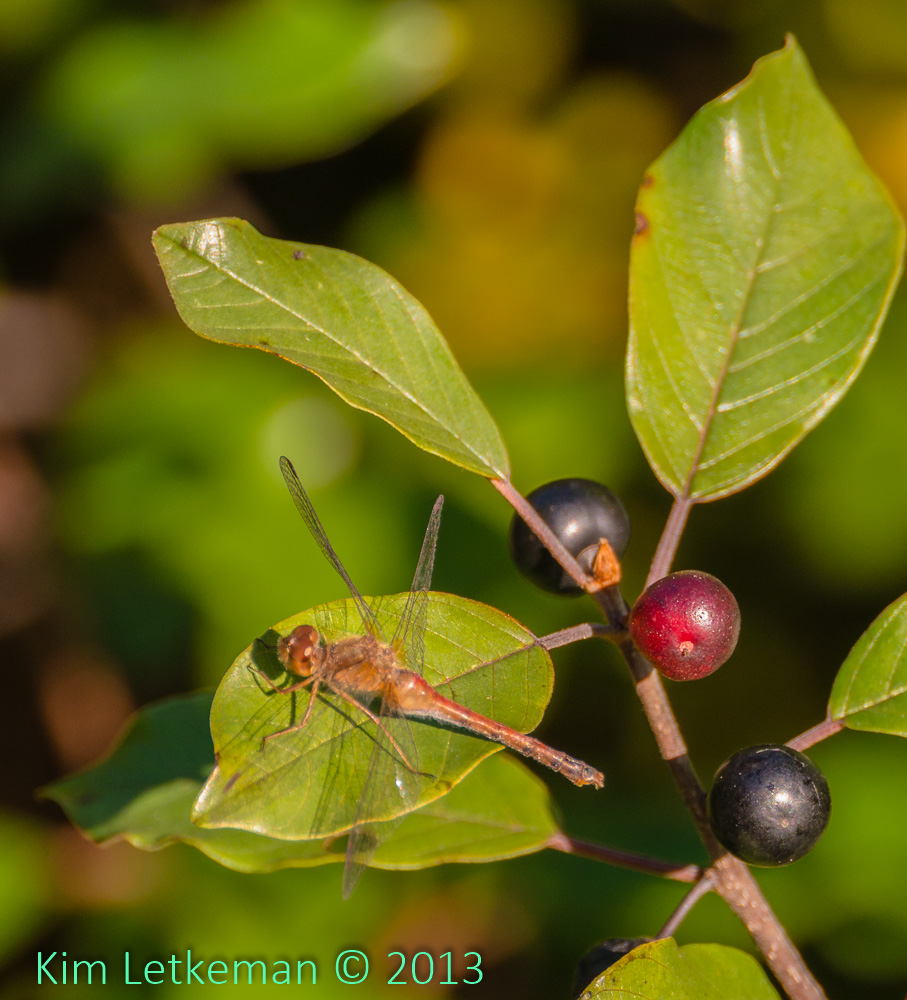
But the body of the color one is quite a bit nicer rendered … although shooting it wide open at 600mm EFL leaves a lot of the insect parts out of focus. Such is life in macro land …

Notice also the missing front leg on his left … ewwwwww …
While I was shooting chickadees and dragonflies, I was also shooting the area around me. Here is another crop comparison …
Here is the G5 looking towards the exit from this particular overlook of the second pond.

And here is the GX1 …

Despite not sharing a sensor heritage (except that Panasonic made both I suppose), they certainly still render pretty similarly. And if I crop the section right at the end of the bridge and magnify it to 200% (2x) I get this:

Click on this one and it will open an external window. Remember to click again to get it to 200% … in my opinion, these two zooms are plenty sharp in the center.
I suppose at some point I should mention that I carried a second small case with the GF3 and Samyang 7.5mm fisheye. I accidentally left it in 16:9 and I slightly oversharpened its images, but this is a nice rendition of the woods on a sunny day in fall …

Another example of why I like this little lens and the GF3 …

Lots more woods images, which I won’t bother showing. I’ve linked the gallery twice now, so please head over there is you are still awake interested.
As I left the woods, I noticed that we have new signs on the outhouses …

I suppose that the universal rule that an outhouse with no sign on it is unisex was not quite enough. And I suppose that it helps to say that the outhouse is wheelchair accessible … after all, this implies that someone tested it. But, of course, there is no way to know that …. and wheelchairs come in rather a lot of different sizes. I would have gone with leaving it unlabeled … but hey, I’m not a city politician :-)
So one more test as I arrive at the car, which is parked in a lot that is below some power wires. As I am basking in the magnetic field caused by high power lines, I am shooting towards the sun in a grand flare test.
The 14-140 on the G5 does not fare very well … and I am a bit surprised.

The GX1 with the 14-42 X PZ fares somewhat better, without the weird multi-colored flare up top, but with a spike jutting out of one side of the sun.

So zooming in closer tames the flare (mostly) on the G5 …

And the flare on the GX1 is about perfect … as in none visible.

So the 14-42 X VARIO PZ is actually a decent lens for both sharpness and flare resistance. However, it lacks range. The 14-140 is terrific at all focal lengths for sharpness, and it does great close ups … but it does not love shooting at the sun.
Trade offs, trade offs …
Anyway, I hope you enjoyed this little walk and the comparisons. I would love to do it again this weekend, but I have a lawn that needs mowing and a pool that needs closing.














































